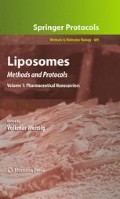Abstract
Cationic liposomes composed of 3β-[N-(N´ N´–dimethylaminoethane)carbamoyl] cholesterol (DC–Chol) and dioleoylphosphatidylethanolamine (DOPE) (DC–Chol/DOPE liposome, molar ratio, 1:1 or 3:2) prepared by the dry-film method have been often used as non-viral gene delivery vectors. We have shown that a more efficient transfection in medium with serum was achieved using DC–Chol/DOPE liposomes (molar ratio, 1:2) than those (3:2), and preparation method by a modified ethanol injection than the dry-film. The most efficient DC–Chol/DOPE liposome for gene transfer was molar ratio (1:2) and prepared by a modified ethanol injection method. The enhanced transfection is related to an increase in the release of DNA in the cytoplasm by the large lipoplex during incubation in opti-MEM I reduced-serum medium (optiMEM), not to an increased cellular association with the lipoplex. Cationic liposomes rich in DOPE prepared by a modified ethanol injection method will help to improve the efficacy of liposome vector systems for gene delivery.
Access this chapter
Tax calculation will be finalised at checkout
Purchases are for personal use only
References
Tranchant I, Thompson B, Nicolazzi C, Mignet N, Scherman D (2004) Physicochemical optimisation of plasmid delivery by cationic lipids. J Gene Med 6:S24–S35
Felgner JH, Kumar R, Sridhar CN, Wheeler CJ, Tsai YJ, Border R, Ramsey P, Martin M, Felgner PL (1994) Enhanced gene delivery and mechanism studies with a novel series of cationic lipid formulations. J Biol Chem 269:2550–2561
Zhang YP, Reimer DL, Zhang G, Lee PH, Bally MB (1997) Self-assembling DNA-lipid particles for gene transfer. Pharm Res 14:190–196
Ross PC, Hui SW (1999) Lipoplex size is a major determinant of in vitro lipofection efficiency. Gene Ther 6:651–659
Turek J, Dubertret C, Jaslin G, Antonakis K, Scherman D, Pitard B (2000) Formulations which increase the size of lipoplexes prevent serum-associated inhibition of transfection. J Gene Med 2:32–40
Almofti MR, Harashima H, Shinohara Y, Almofti A, Li W, Kiwada H (2003) Lipoplex size determines lipofection efficiency with or without serum. Mol Membr Biol 20:35–43
Hattori Y, Maitani Y (2005) Folate-linked nanoparticle-mediated suicide gene therapy in human prostate cancer and nasopharyngeal cancer with herpes simplex virus thymidine kinase. Cancer Gene Ther 12:796–809
Zhou X, Huang L (1994) DNA transfection mediated by cationic liposomes containing lipopolylysine: characterization and mechanism of action. Biochim Biophys Acta 1189:195–203
Farhood H, Gao X, Son K, Yang YY, Lazo JS, Huang L, Barsoum J, Bottega R, Epand RM (1994) Cationic liposomes for direct gene transfer in therapy of cancer and other diseases. Ann N Y Acad Sci 716:23–34 discussion 34–35
Farhood H, Serbina N, Huang L (1995) The role of dioleoyl phosphatidylethanolamine in cationic liposome mediated gene transfer. Biochim Biophys Acta 1235:289–295
Nabel GJ, Nabel EG, Yang ZY, Fox BA, Plautz GE, Gao X, Huang L, Shu S, Gordon D, Chang AE (1993) Direct gene transfer with DNA-liposome complexes in melanoma: expression, biologic activity, and lack of toxicity in humans. Proc Natl Acad Sci U S A 90:11307–11311
Nabel EG, Yang Z, Muller D, Chang AE, Gao X, Huang L, Cho KJ, Nabel GJ (1994) Safety and toxicity of catheter gene delivery to the pulmonary vasculature in a patient with metastatic melanoma. Hum Gene Ther 5:1089–1094
Maitani Y, Igarashi S, Sato M, Hattori Y (2007) Cationic liposome (DC–Chol/DOPE=1:2) and a modified ethanol injection method to prepare liposomes, increased gene expression. Int J Pharm 342:33–39
Ding W, Hattori Y, Higashiyama K, Maitani Y (2007) Hydroxyethylated cationic cholesterol derivatives in liposome vectors promote gene expression in the lung. Int J Pharm. doi:10.1016/j.ijpharm.2007.10.051
Maitani Y, Soeda H, Wang J, Takayama K (2001) Modified ethanol injection method for liposomes containing β-sitosterol β-D-glucoside. J Liposome Res 11:115–125
Kremer JMH, van der Esker MW, Pathmamanoharan C, Wiersems PH (1977) Vesicles of variable diameter prepared by a modified injection method. Biochemistry 16:3932–3935
Perrett S, Golding M, Williams WP (1991) A simple method for the preparation of liposomes for pharmaceutical applications: characterization of the liposomes. J Pharm Phaarmacol 43:154–161
Park K, Lee M, Hwang K, Kim C (1999) Phospholipid based microemulsions of flurbiprofen by the spontaneous emulsification process. Int J Pharm 183:145–154
Ishii F, Takamura A, Ishigami Y (1995) Procedure for preparation of lipid vesicles (liposomes) using the coacervation (phase separation) technique. Langmuir 11:483–486
Bangham AD, Standish MM, Watkins JC (1965) Diffusion of univalent ions across the lamellae of swollen phospholipids. J Mol Biol 13:238–252
Danev R, Nagayama K (2006) Applicability of thin film phase plates in biological electron microscopy. Biophysics 2:35–43
Author information
Authors and Affiliations
Corresponding author
Editor information
Editors and Affiliations
Rights and permissions
Copyright information
© 2010 Humana Press, a part of Springer Science+Business Media, LLC
About this protocol
Cite this protocol
Maitani, Y. (2010). Lipoplex Formation Using Liposomes Prepared by Ethanol Injection. In: Weissig, V. (eds) Liposomes. Methods in Molecular Biology, vol 605. Humana Press. https://doi.org/10.1007/978-1-60327-360-2_27
Download citation
DOI: https://doi.org/10.1007/978-1-60327-360-2_27
Published:
Publisher Name: Humana Press
Print ISBN: 978-1-60327-359-6
Online ISBN: 978-1-60327-360-2
eBook Packages: Springer Protocols

